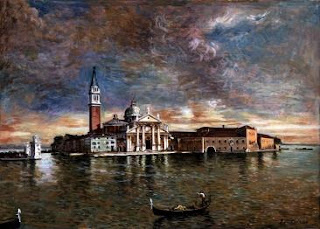SAN GIORGIO MAGGIORE: PAINTING A
I do not know why, but there are several churches in Venice whose facades look towards the west. San Marco, San Zaccaria, San Francesco alla Vigna, ... Premeditated or not, the light of sunset gives them a bright color that stands out even more to be built in white marble.
Facing the Piazzetta of San Marcos, between the two columns are the mark of entry into the city of the Lord, you can see the island of San Giorgio. In it, as a beacon of welcome to Venice, stands a church designed by Palladio.
San Giorgio Maggiore is a work of art, technical and aesthetic characteristics can see in the blog of Vincent . A work of art is enhanced by its setting. Even the most planned cities can match the perspective of this building.
Baroque urbanism concept, which highlights the space surroundings as part of a monument uses staircases, spacious plazas, ramps and colonnades surrounding the scene and magnify the object of contemplation.
Here the square is the lagoon, the mirror stage in which is reflected from changing viewpoints, not elected, fleeting. We can not remain as we approach either, because we sail. This makes it a game of Baroque illusions. And tremendously plastic.
The cast of artists who have felt trapped by it is very long. The tradition of the eighteenth century veduta from Guardi and Canaletto, watching as reproductions capture interest monumental spaces and picturesque.
Of all the scenarios painted by vedutista, only San Giorgio has continued to attract the greatest of all time. Perhaps
Palladio did not know that, at the end of the work, began the "other" construction of San Giorgio. is a work in progess. perceive architecture is practically only impossible if the vision is influenced by other artists who have passed. We tend to appreciate values \u200b\u200bwhich they could have gone unnoticed. Shrouded in fog, backlit, bathed in the light of the sun, each artist has internalized, and has painted himself as a self-portrait painting in San Giorgio.

C analetto and Venice, is inseparable. Detailed architecture, atmospheric effects without neglecting the picturesqueness of Figures situate humanas.No forget the sun, full of warmth as a reflection on the water.

Turner captures the view of the church from the Giudecca, the amanecer.La beauty of this watercolor is a milestone for its synthesis, and an almost photographic.
Rushkin, the first head of Venice's first tourist boom, made a lot of pictures during his visit, published in "The Stones of Venice." The book became a best-seller that took to Venice, among others, Proust.
The Mysterious Whistler, passionate views against the muted tones and highlighted the blurred silhouettes in San Giorgio bruma.Su could be any port, only the shape of the campanile puts us in the right scenario.

Boudin was primarily a marine painter. Accustomed to the changing skies of Normandy, the gap appears to him with a deep blue short, quick stroke celeste.Su be an inspiration to Monet. In this case the view is from San Giorgio, the enbarcadero on the right is the one that leads to the church.

Corot's compositions are always calm and serene. Fixed interest in the midtones, which summarizes in compact masses and harmonic

is another point of view, but the interests are the same. Vertical and horizontal lines crisscrossing the composition, and a model for spot highlighted in the sky and ground.

Venice Monet painted many times. In this the cut silhouette of our church stands out among a sunset that enhances the tones to stay ahead of the Fauves.

Renoir
applied brushstroke decomposed into shreds the filtered light of the trees, to represent the water of the lagoon. As always, knows how to bring the widest range of shades to black. It is one of his great painting resources.
Signac worked with primary colors, and applied the theory of complementary contrast. The green water against the red brick cover in yellow against purple sky. To Cros, is a wonderful exercise in pointillism. Each color vibrates in the water allowing plenty of color combinations. 
De Dufy can say that whatever you do, always a Dufy.Liberado of any convention on how to deal with painting, graphic lines and introduces a colorful contours, where line, Fauve.
The most celebrated also have an avant-garde classical past. Giorgio de Chirico.Se recognizes in him the space concern, and the oppressive atmosphere of the paintings alone all associate with him.

And finally, Kokoschka. Unmistakable and unstoppable, the gestural and color burst is the real subject of the painting, which is guessed in the distance, the shape of San Giorgio.















0 comments:
Post a Comment